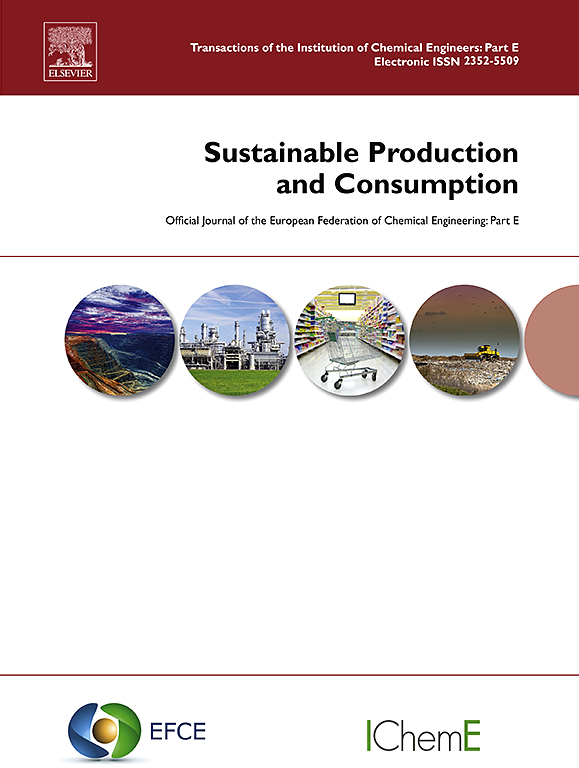黄麻袋作为孟加拉国一次性塑料袋的可持续替代品:重新思考对生命周期评估的唯一依赖
IF 9.6
1区 环境科学与生态学
Q1 ENVIRONMENTAL STUDIES
引用次数: 0
摘要
在孟加拉国独特的三角洲地理环境中,管理不善的塑料废物对人类健康和水生生态系统构成了重大挑战。这是由于废物管理不足、乱扔垃圾和陆地上塑料处理不当造成的。孟加拉国用可生物降解的替代品替代塑料与黄麻产品密切相关,这是由于其文化意义和恒河三角洲长期种植黄麻的传统所推动的。本研究采用基于国际标准化组织(ISO)的综合生命周期评估(LCA)来评估黄麻和塑料袋从原材料提取到处置的整个生命周期。生命周期评估所选择的功能单位是孟加拉国每人每年携带食品杂货所需的袋数,根据人均粮食需求量269.20公斤计算,结果是人均27个袋。一次性塑料袋的潜在碳足迹测量为56.7克二氧化碳当量(二氧化碳当量),而一次性黄麻袋产生313.41克二氧化碳当量。与塑料袋相比,这一数字增长了五倍。一次性使用的黄麻袋对环境的不利影响可归因于其重量比薄塑料袋高出近十倍,因此需要相应的更多原材料用于生产。在陆地生态毒性的范畴中,塑料袋显示出很大的缺点。在一次性使用的情况下,塑料袋在18个影响类别中有17个优于黄麻袋。然而,与一次性低密度聚乙烯(LDPE)袋相比,在多次使用(10次)的情况下,黄麻袋在大多数影响类别中表现出优越的性能。通过考虑满足功能单位所需的袋子数量,以及诸如重量、表面积、价格和生物降解性等因素,得出了评估环境垃圾风险的措施。弃置垃圾风险指标(Ilr)提供的结果与LCA的结果相矛盾。两种袋的Ilr值差异显著,黄麻袋的Ilr值较低,为0.65,表明环境凋落物风险最小。相比之下,LDPE袋的价值高得惊人,高达29,566,突出了大量乱扔垃圾的风险。本文主张进行更全面的评估,以便更好地为可持续选择提供信息,并有效地减轻对环境的影响。认识到LCA的局限性,特别是在评估垃圾和物质持久性方面,该研究强调需要在未来的研究中解决这些限制。本文章由计算机程序翻译,如有差异,请以英文原文为准。
Jute bags as a sustainable alternative to single-use plastic bags in Bangladesh: Rethinking the sole reliance on life cycle assessment
In the unique deltaic geography of Bangladesh, mismanaged plastic waste presents significant challenges to human health and aquatic ecosystems. This is due to insufficient waste management, littering, and improper plastic disposal on land. The substitution of plastic with biodegradable alternatives in Bangladesh is closely linked to jute products, driven by their cultural significance and the longstanding tradition of jute cultivation in the Ganges delta.
This study utilizes a comprehensive Life Cycle Assessment (LCA) based on International Organization for Standardization (ISO) to evaluate jute and plastic bags throughout their life cycles, from raw material extraction to disposal. The selected functional unit for life cycle assessments is the number of bags necessary to carry the annual groceries per person in Bangladesh, calculated from the average per capita food requirement of 269.20 kg, resulting in 27 bags per capita. The potential carbon footprint for a single-use plastic bag is measured at 56.7 g carbon di-oxide equivalent (CO2-eq.) while the single-use jute bag results in 313.41 g CO2-eq., marking a fivefold increase compared to the plastic bag. The less favorable environmental impacts for single-use jute bags can be attributed to their nearly tenfold higher weight than a thin plastic bag, necessitating a correspondingly higher quantity of raw materials for production. In the category of terrestrial ecotoxicity, the plastic bag exhibits substantial disadvantages. The plastic bag outperforms the jute bag in 17 out of 18 impact categories in single-use scenarios. However, with multiple uses (ten times), the jute bag demonstrates superior performance in most impact categories compared to the single-use low-density polyethylene (LDPE) bag. A measure for assessing the risk of environmental littering is derived by considering the quantity of bags required to fulfill the functional unit, along with factors such as weight, surface area, price, and biodegradability. The outcomes provided by the littering risk indicator (Ilr) contradict those obtained through LCA. The value of Ilr is significantly different between the two types of bags, with the jute bag showing a lower value of 0.65, indicating minimal environmental litter risk. In contrast, the LDPE bag has an alarmingly high value of 29,566, highlighting a substantial littering risk. The paper advocates for a more holistic assessment to inform sustainable choices better and mitigate environmental impacts effectively. Recognizing the limitations of LCA, particularly in assessing littering and material persistence, the study emphasizes the need to address these constraints in future research.
求助全文
通过发布文献求助,成功后即可免费获取论文全文。
去求助
来源期刊

Sustainable Production and Consumption
Environmental Science-Environmental Engineering
CiteScore
17.40
自引率
7.40%
发文量
389
审稿时长
13 days
期刊介绍:
Sustainable production and consumption refers to the production and utilization of goods and services in a way that benefits society, is economically viable, and has minimal environmental impact throughout its entire lifespan. Our journal is dedicated to publishing top-notch interdisciplinary research and practical studies in this emerging field. We take a distinctive approach by examining the interplay between technology, consumption patterns, and policy to identify sustainable solutions for both production and consumption systems.
 求助内容:
求助内容: 应助结果提醒方式:
应助结果提醒方式:


